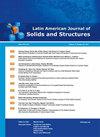The effects of tether pretension within vertebral body tethering on the biomechanics of the spine: a Finite Element analysis
IF 1.1
4区 工程技术
Q3 ENGINEERING, CIVIL
引用次数: 2
Abstract
This study investigates the biomechanics of the spine after insertion of vertebral body tethering (VBT) with different cord pretensions. For that purpose, a Finite Element model of the average thoracolumbar spine was stepwise calibrated and validated. The VBT instrumentation was inserted in the left side of the L1-L2 segment with different cord pretensions. As a second test, the L1-L2 segment was submitted to an external pure moment of 6 Nm in left and right lateral bending. The range of motion (ROM) for the spine with VBT was determined with respect to its initial post VBT position. Pretension forces of 100 N and 300 N resulted in a change of scoliotic angle of 2.7° and 5.3° to the left side of the spine, respectively. The ROM of the native spine was 4.5° in right lateral bending and reduced to 1.8° and 1.4° for the cases of the spine with a cord pretension of 100 N and 300 N, respectively. In left lateral bending, the absolute ROM of the native spine was 4.6°. For the cases of a cord pretension of 100 N and 300 N, the spine bent 1.9° and 0.8° to the left side from its initial post VBT position, respectively.椎体系留术中系留预紧力对脊柱生物力学的影响:有限元分析
本文章由计算机程序翻译,如有差异,请以英文原文为准。
求助全文
约1分钟内获得全文
求助全文
来源期刊
CiteScore
2.80
自引率
8.30%
发文量
37
审稿时长
>12 weeks

 求助内容:
求助内容: 应助结果提醒方式:
应助结果提醒方式:


